The Qualcomm Snapdragon 820 Performance Preview: Meet Kryo
by Ryan Smith & Andrei Frumusanu on December 10, 2015 11:00 AM EST- Posted in
- SoCs
- Snapdragon
- Qualcomm
- Snapdragon 820
GPU Performance
Shifting gears, let’s take a look at GPU performance. As we mentioned earlier, Qualcomm isn’t disclosing much about this GPU other than that it packs quite a bit more computational power than its predecessor and should be quite a bit faster in the process. This points to a potentially significant architectural shift, but that determination will have to wait for another time.
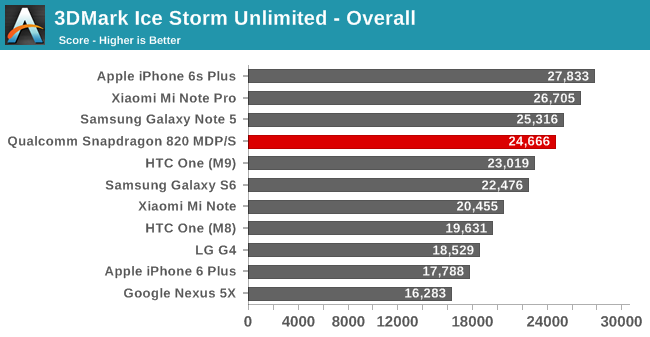
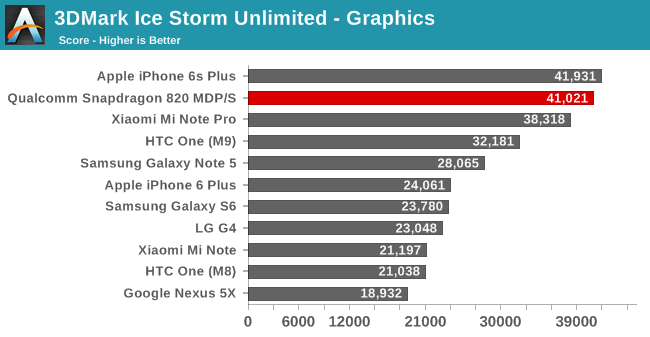
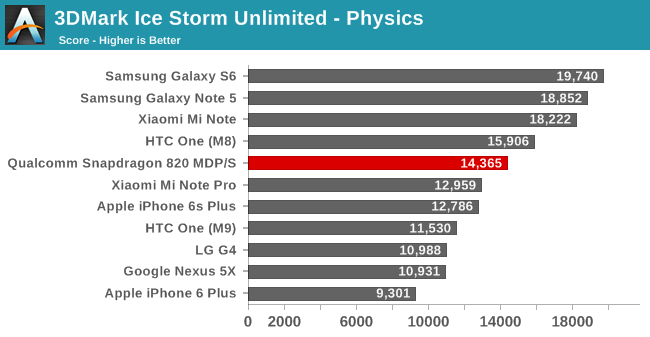
Starting with 3DMark Ice Storm Unlimited, the performance honestly doesn’t start out great. The overall score is significantly influenced by the physics score, which in turn is more concerned with the number of cores and their throughput on simple code than the ability to extract complex IPC. As a result the 4 CPU core 820 simply can’t catch up with the likes of the Samsung devices and their high-clocked big.LITTLE configurations. On the other hand the graphics score makes this the fastest Android phone to date, though relative to the 810 Mi Note Pro, perhaps not by a ton. Ultimately as this is an OpenGL ES 2.x test it’s not the most strenuous of tests these days, and comments from Qualcomm indicate that it may be a CPU-limited test on 820.
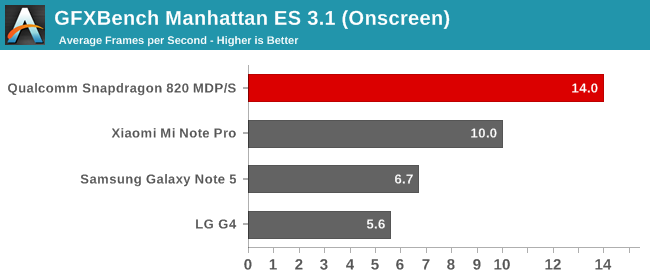
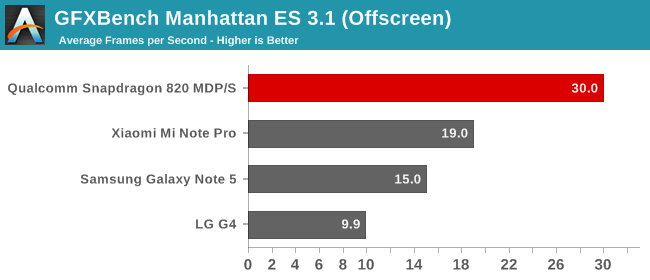
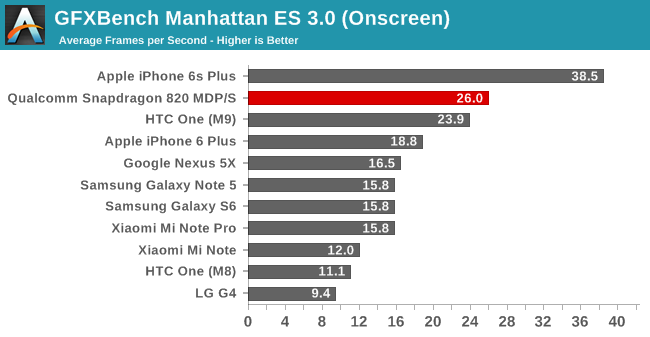
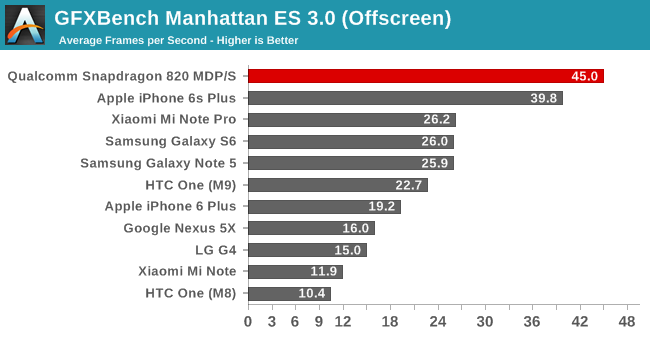
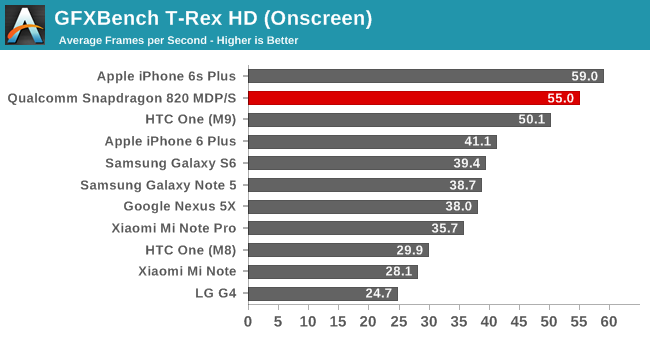
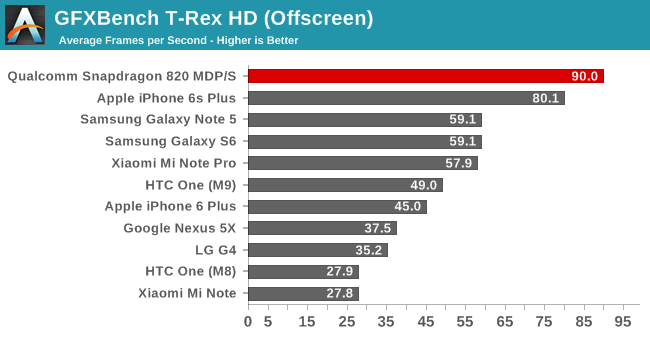
GFXBench on the other hand shows some massive gains for the 820 relative to any other Android device. In offscreen rendering mode, all 3 game tests – Manhattan ES 3.1, Manhattan ES 3.0, and T-Rex HD – put the 820 MDP/S as being 52% (or more) faster than the next-fastest Android device, either the 810 based Mi Note Pro or the Exynos 7420 based Samsung Galaxy Note 5. The single biggest jump we see is with Manhattan ES 3.0 at 72%, while the ES 3.1 version dials that back down to 52%. Even the iPhone 6s Plus, well known for its powerful GPU, is handily and consistently surpassed by the 820 here. Only due to the 6s Plus’s lower rendering resolution of 2208x1242 does it surpass the MDP/S in onscreen tests, as the latter needs to render at 2560x1600 (~50% more pixels). Qualcomm was aiming for some big GPU performance gains here and so far they are delivering.

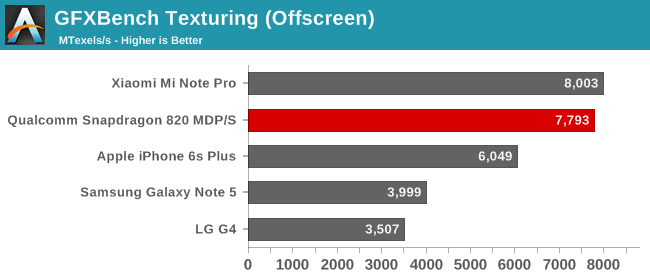
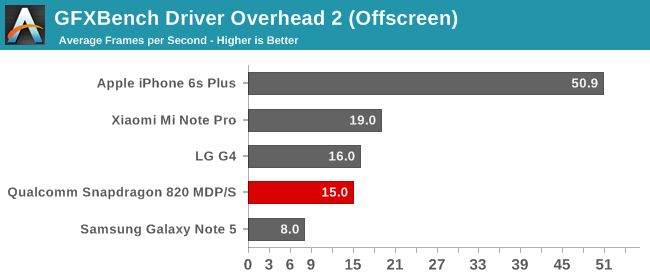
Curiously, GFXBench’s synthetic feature tests don’t show the same gains. Offscreen ALU performance is only slightly improved over the 810 (10%) or in the case of texturing is an outright regression. None-the-less full gaming performance is clearly in the 820’s favor. I’ve long suspected that the Adreno 430 GPU in the 810 had some kind of architectural bottleneck – perhaps an ALU/texture array that was difficult to fully utilize – and what we’re seeing here would back up that claim, as if that was the case then correcting it would have allowed Qualcomm to significantly boost their rendering performance while only barely changing their synthetic performance. Otherwise I find it a bit surprising that the driver overhead score is a bit worse on 820 than 810, which may be a result of the immature GPU drivers on this early device.










146 Comments
View All Comments
lucam - Friday, December 11, 2015 - link
So if the chip is not heating up it's not a problem, we need to wait if the phone heating up too...very weird point of view..Impulses - Friday, December 11, 2015 - link
Your backwards interpretation of what he said is the only weird thing.ganz - Friday, December 11, 2015 - link
Thanks @tipoo and @jjj. It's just that I see people posting stuff like, "The device get [sic] unnaturally hot." I parse this complaint to mean, "Ow, my hand!", not, "Dang, why so slow?"I think yours is the valid complaint, but what I keep reading are comments like @Krysto's here. And I still think @Krysto and others are actually complaining about the device becoming uncomfortable to hold.
My meaning is this: "Quantify your complaint, @Krysto" If it's *really* the heat (really?), how hot is too hot? If it's the performance, maybe say so.
extide - Thursday, December 10, 2015 - link
Supporting the SHA1 instructions is part of being ARMv 8 compliant -- it's not really their choice...lilmoe - Thursday, December 10, 2015 - link
On the first chart, the memory controller stack of the 820 should be 64bit dual channel.tipoo - Thursday, December 10, 2015 - link
Mixed feels. A move away from the frankly bad Cortex A57 cores, cool. But you could pretty well tell from the very first page that this was set to punch below A9, coudn't you? Longer latencies on float, int, 1/3rd the L2, no L3 at all. And particularly as a big.LITTLE design that means less sharing between high power/low power core clusters.And unlike S810, there's 2, not 4, "big" cores to at least make up for the lackluster IPC 810 had compared to A9.
Just think their aim wasn't high enough...Again...
r3loaded - Thursday, December 10, 2015 - link
Oi, don't slate the A57! Those cores run beautifully in Samsung's Exynos 7 without overheating or throttling, and performance of that SoC is broadly comparable to the A8.Integration and implementation are just as important as the initial selection of IP blocks for an SoC.
tuxRoller - Thursday, December 10, 2015 - link
You're forgetting that Samsung had a rather significant process advantage. Take that away, and they'd need to lower their clocks to sd808 levels, is imagine.Andrei Frumusanu - Thursday, December 10, 2015 - link
The Exynos 5433 runs quite better than the Snapdragon 808.tuxRoller - Thursday, December 10, 2015 - link
According to wikipedia it's clocked at 1.9ghz, which is right around the snapdragon 808.